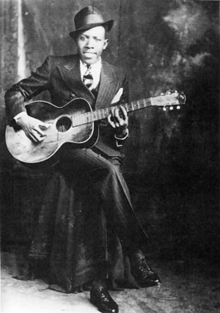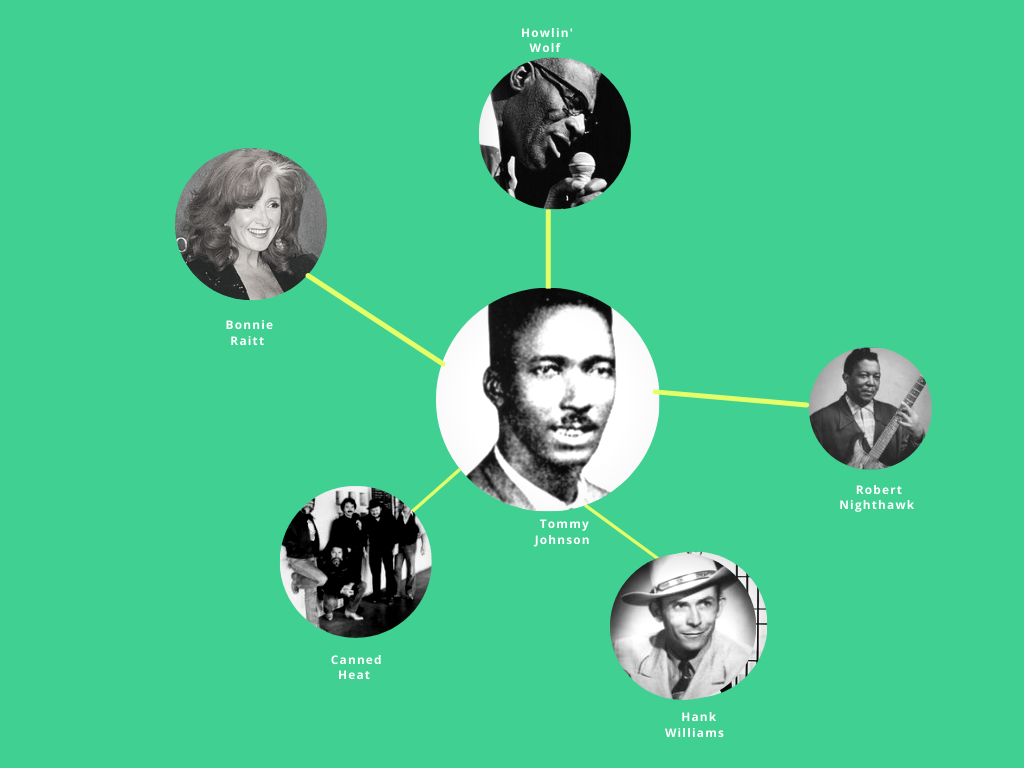
Cryin’, sun gonna shine in my back door someday
Now, don’t you hear me talkin’, pretty mama?
Lord, sun gon’ shine in my back door someday
And the wind gon’ change, gon’ blow my blues away
In this week’s Musical Tree, we are going to talk about a legendary Mississippi Delta Blues musician who is credited with having a huge influence over Delta Blues music even though his name and legacy are often overlooked. He is also credited with originating the fable of making a deal with the devil at a crossroads. This is the story of Tommy Johnson.
Tommy Johnson was born in Hinds County, Mississippi in January 1896. In 1910 he moved to Crystal Springs, Mississippi where he lived for most of his life. It was there where he learned the guitar around 1914. He began performing with his brothers at local parties to supplement his income. In 1916 he married and moved to Webb Jennings plantation which was close to the larger Dockery plantation and allowed him to meet other blues musicians including Charley Patton.
Charley Patton was a huge influence on Johnson, and his songs and guitar playing improved. Johnson continued playing throughout the 1920’s at parties and local gatherings. Life for plantation workers was tough, and music, as it had been back in the days of slavery, was often an escape for the workers. Weekends would find plantation workers flooding the nearest town to listen to music, dance, play cards, and generally blow off steam until it was time for church on Sunday.
Around this time Colliers magazine wrote an article about one such town, Leland Mississippi, calling it the ‘hellhole of the Delta’. As many as 10,000 people from the plantations would flock there on Saturday nights. Bluesmen would play on street corners and clubs until dawn. The local anti-saloon league tried to shut this activity down but were unsuccessful. They claimed that the town’s moral problems were caused by ‘blind tiger booze, crap shooting, and kept women’. As one observer remarked, no wonder people flocked there! In 1928 Johnson was playing in Jackson, Mississippi and heard that a talent scout from the Victor recording company was auditioning talent. Johnson auditioned and was hired to record songs. Johnson recorded six songs, including ‘Canned Heat Blues’, a song about drinking methanol from cooking Sterno. The rock group Canned Heat took their name from this song, and their hit song ‘On The Road Again’ was loosely based on Tommy Johnson’s song ‘Big Road Blues’.
Johnson recorded two more sessions, one for Victor in August of 1928 and then for Paramount Records in December of 1929. All told, Tommy Johnson only recorded 20 songs and why he stopped recording is somewhat of a mystery. Some believe that Johnson thought he had mistakenly sold away his rights, which resulted in him signing an agreement with Paramount to let the blues group Mississippi Sheiks release their song ‘Stop and Listen’, which used the melody of Johnson’s ‘Big Road Blues’. Some have suggested that Johnson was too drunk at the time to understand what he had signed. Whatever the reason, Johnson’s abuse of alcohol, Sterno (Canned Heat) and Jake (Jamaican ginger extract–the subject of his final recording ‘Alcohol and Jake Blues’) took their toll on him. No one knows exactly how many records he sold, but his recording career was just 20 songs.
Tommy Johnson built his legacy, and influence, by performing. Blues musicians in the area all claimed that they never heard his records. Instead they learned to emulate his high falsetto vocals and unique guitar phrasings from seeing him perform live. Johnson’s voice could range from a low growl to a high falsetto – that falsetto no doubt inspired by fellow Mississippian Jimmie Rodgers. As for his guitar playing, before we get to that we need to indulge a popular myth associated with blues legend Robert Johnson, who was not related to Tommy Johnson. By now we have all heard the myth of a Mississippi bluesman selling his soul to the devil at a crossroads. This story has always been attributed to Robert Johnson. However, Tommy’s older brother LeDell Johnson actually told that story to folklorist David Evans long before Robert Johnson claimed the infamous encounter at the crossroads. According to LeDell Johnson, Tommy disappeared for a period of a few months, but when he came back his guitar playing had improved dramatically. Tommy told LeDell that he had met a large dark man one evening at a crossroads. This man, supposedly the devil, strummed a few songs on the guitar before handing it back to him. In exchange for his soul, Tommy Johnson’s guitar skills improved tremendously.

Whether it was the devil, hard work, talent, or a combination, Tommy Johnson’s guitar skills for the time were legendary and made him must see entertainment. When performing live Johnson would throw his guitar up in the air and catch it without missing a note. He could play behind his head and with the guitar between his legs. This quote from Houston Stackhouse, a fellow Delta musician who saw Tommy perform live, captures it perfectly – “He’d kick the guitar, flip it, turn it back of his head and be playin’ it. Then he’d get straddled over it like he was ridin’ a mule – pick it that way”. Long before Jimi Hendrix would electrify crowds with his tricks while playing the guitar, Tommy Johnson was doing the same to crowds in the Mississippi Delta. After Tommy Johnson stopped recording he continued playing throughout the 1930’s and 1940’s. He mostly played small clubs and parties in the Jackson, Mississippi area, where he remained very popular. His fame never grew out of that area, yet his influence was huge because Johnson was willing to teach other performers his style and his repertoire. His talented songwriting blended folk style lyrics with blues arrangements that led to great songs such as ‘Maggie Campbell Blues’.

Robert Johnson gets much of the credit for originating Delta Blues music. Robert Johnson recorded his songs ten years after Tommy Johnson made his recordings. Even though there is no documented meeting between the two musicians, it’s hard to believe that their paths did not cross in and around the Mississippi Delta. It is very likely that Tommy Johnson had some level of influence over Robert Johnson. Indeed, Robert Johnson even borrowed Tommy Johnson’s story about meeting the devil at a crossroads to help garner publicity. Robert Johnson’s sudden death left him with a limited amount of recorded songs, but the mystery around his death only helped fuel his legacy. One can’t argue with his impact on blues music but, prior to the emergence of Robert Johnson in the late 1930’s, there was not a bigger influence on Delta Blues music than Tommy Johnson. Had Tommy Johnson recorded more songs and played outside of Mississippi I would argue that he would have had an equal, if not bigger, impact than Robert Johnson. Blues legends Howlin’ Wolf, Robert Nighthawk, and even country legend Hank Williams all cite Tommy Johnson as a huge influence. Look at the lyrics to his songs and you can see snippets that other blues artists used for popular songs such as ‘C.C. Rider’ and ‘I Know You Rider’. For someone who only recorded twenty songs, that is quite remarkable. Each year the city of Crystal Springs hosts the Tommy Johnson Blues Festival on the third weekend of October. In 1986 Tommy Johnson was inducted into the Blues Hall of Fame.
Tommy Johnson died of a heart attack after playing at a party in Jackson in 1956. He was 60 years old. He was buried in a cemetery outside Crystal Springs, Mississippi. There was no headstone for his grave. In 2000 his family gave permission for a headstone to be placed on his grave and Bonnie Raitt helped spearhead funding for the headstone, which included a portrait of the singer along with the names of some of his most famous recordings. Sadly, it would take ten years for the headstone to be erected due to disputes with land owners who surrounded the cemetery. The headstone was finally erected in October of 2012.
On the evening of Saturday, February 2, 2013, just a few months after it had been erected, the headstone at Tommy Johnson’s grave fell and was damaged. No one knows how it fell. Perhaps it had not been secured properly. Or maybe it was deliberately pushed over. Either way it shouldn’t be a surprise that it happened on a Saturday night, harking back to those wild nights on the Delta. If you close your eyes, maybe, just maybe, Tommy Johnson himself got a little carried away on that Saturday night, throwing and picking his guitar, not having a care in the world if his headstone was damaged or not. Perhaps the winds did change, and blew his blues away.
I hope you enjoyed this week’s Musical Tree. Feel free to leave suggestions for future articles in the comments. Don’t forget to subscribe to be notified via email when there is a new post.
And you can now follow Tekesmusings.com on your social media of choice by clicking on the links at the bottom of the page! Until then, follow your passion, stay happy, and be thankful for whatever inspires you.

Tree

I like knowing about these lesser known bluesmen. Well done.
Pingback: Charley Patton – Teke's Musings
Pingback: Musical Tree Twenty! – Teke's Musings